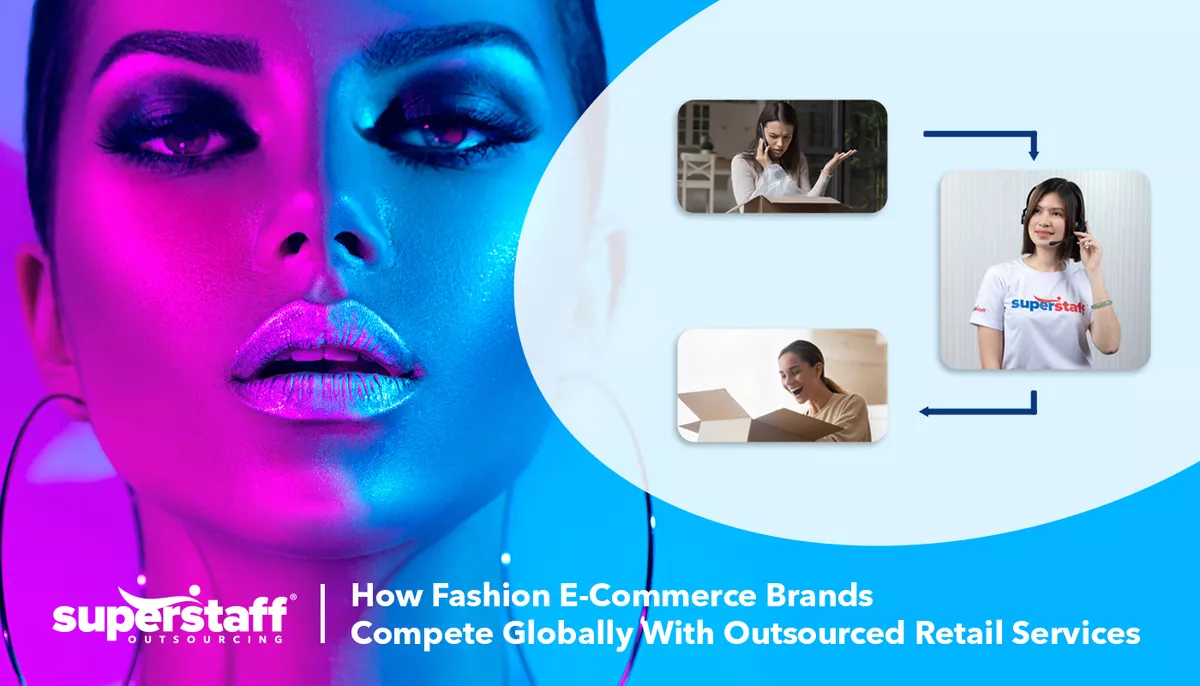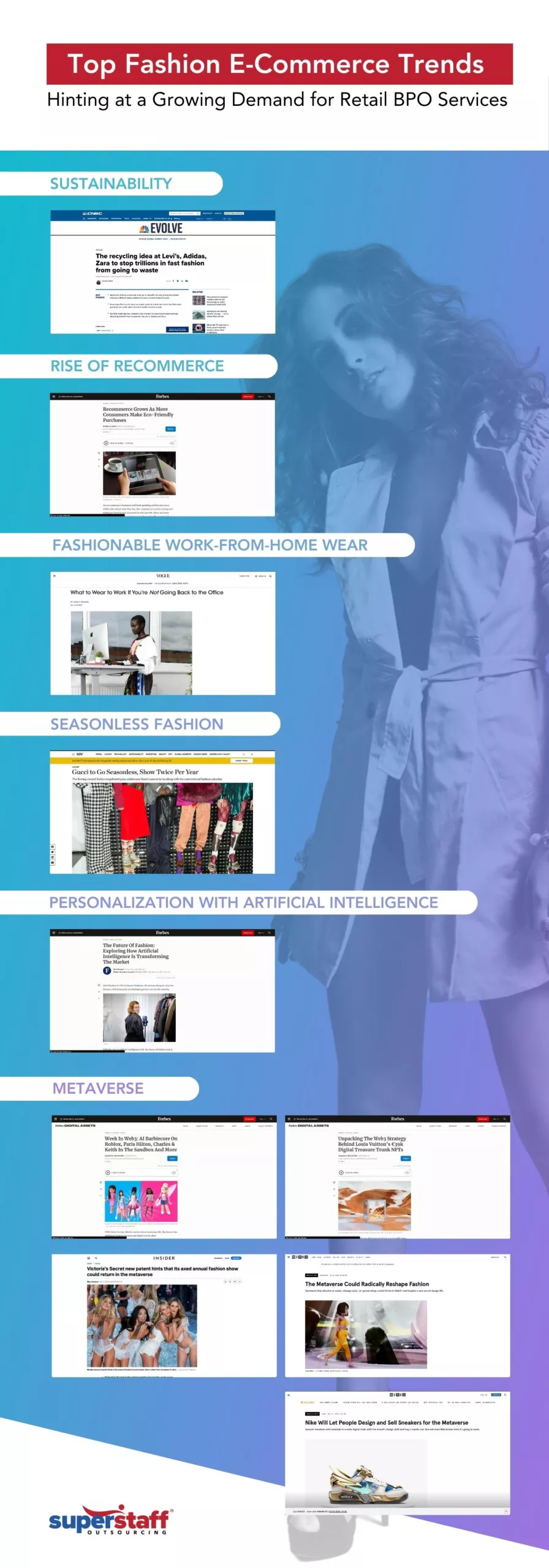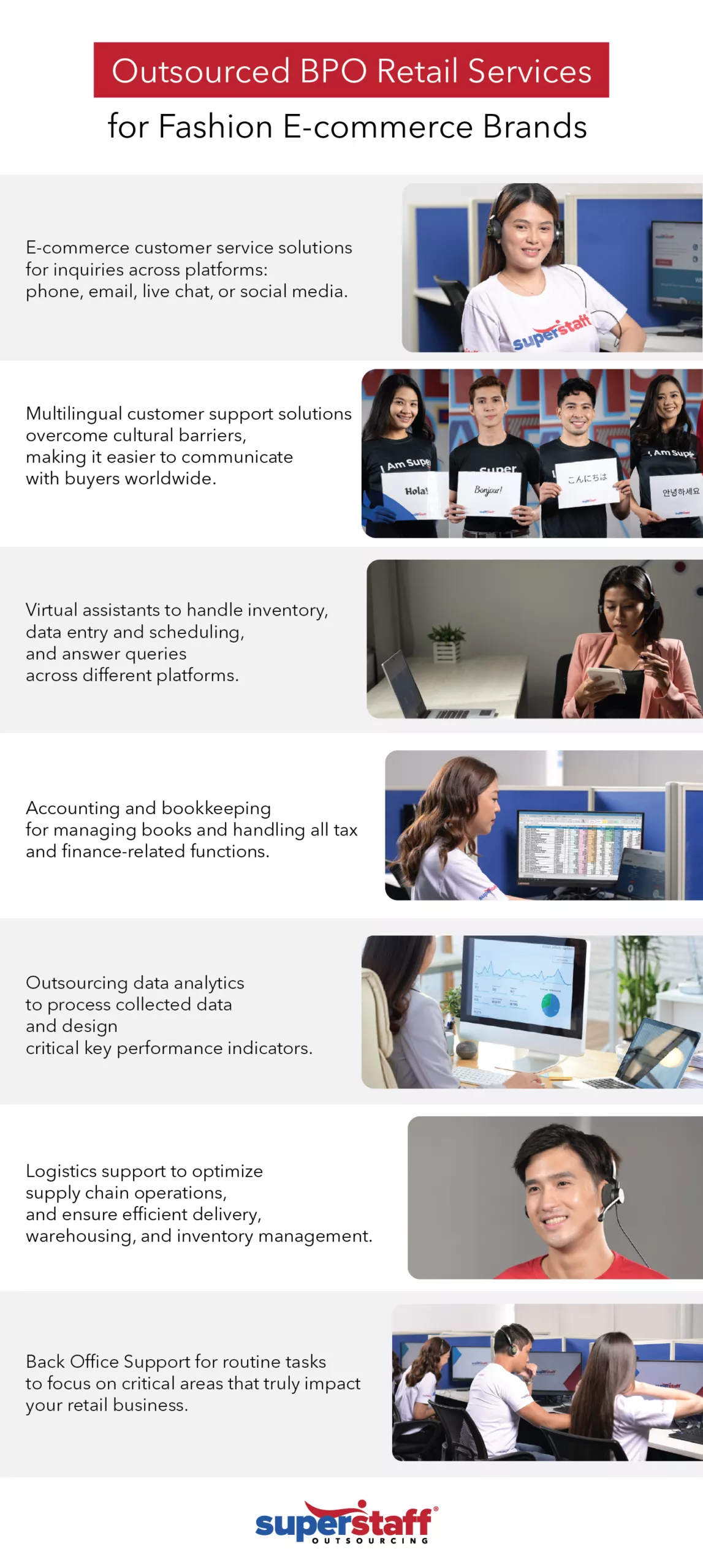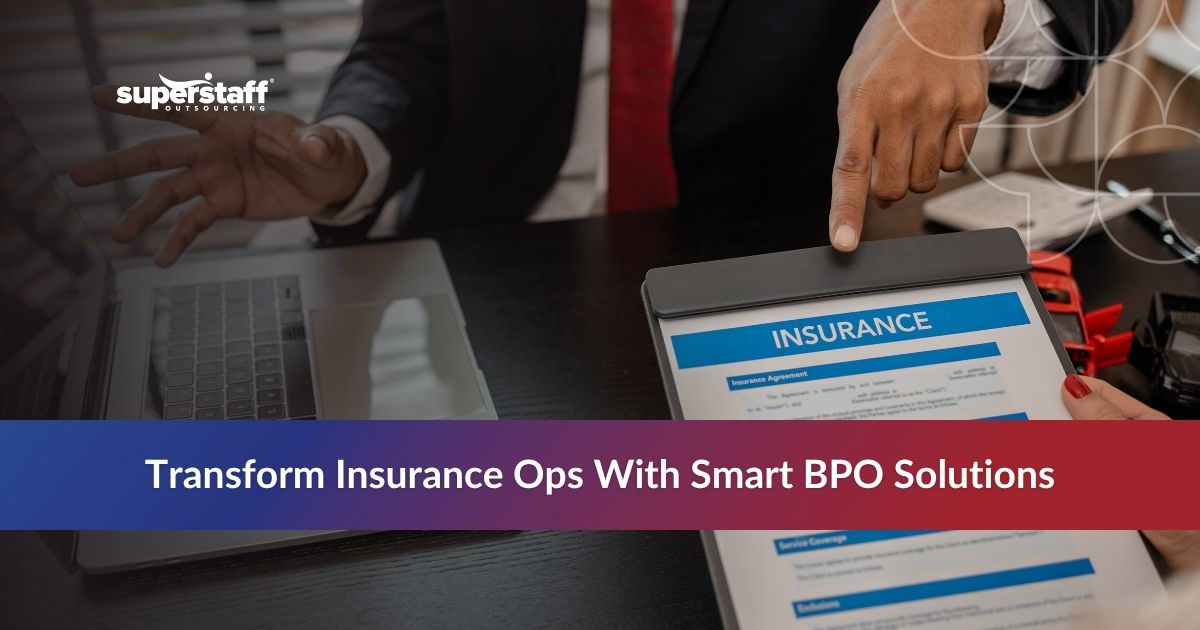
In the post-pandemic world, digital solutions have become essential for businesses. And this is especially true for the fashion industry, which faced immense challenges during the COVID-19 crisis.
Since consumers had to stay home to avoid contracting the virus, they began seeing physical shopping as a risky venture. As such, e-commerce has become crucial for any fashion retail store, allowing customers to shop for their favorite brands from the comfort and safety of their homes.
In this article, we’ll take a closer look at how digital solutions have shaped the future of fashion retailers. Then, we’ll tackle the latest trends dominating the e-commerce fashion industry, how brands can use these strategies to stand out from the competition, and how outsourced retail services can help these businesses succeed.
The State of the E-Commerce Fashion Industry: Statistics, Trends, and Strategies to Use in 2023
Gone are the days when fashion brands relied on a brick-and-mortar retail store to make a sale. They had to adapt to the pandemic challenges by transforming physical stores into online ones. In 2019 alone, only 10 to 15% of luxury brands prioritized e-commerce, but at least half of luxury brand sales were made online by the following year.
Embracing digital solutions allowed the industry to prosper, with online sales for luxury brands increasing during the pandemic. Even top brands such as Louis Vuitton, Chanel, Gucci, and Swarovski, who were once slow to transition to digital, had to adapt to the changes in the global marketplace.
Fashion startups are now disadvantaged because every retail company seeks attention in the increasingly crowded digital landscape. Thankfully, there are ways for growing online fashion stores to stand out online, starting with staying on top of the latest fashion e-commerce trends and strategies.

Increased Demand for Personalization Among Online Shoppers
In today’s competitive marketplace, having high-quality products that customers would want to purchase is no longer enough. Investing in customer-centric service is a critical competitive differentiator for the fashion e-commerce industry.
In the past, fashion retailers expected consumers to respond to and engage with similar advertisements and messaging, regardless of age, gender, location, or other characteristics. Today, online shoppers expect their chosen fashion brands to treat them as individuals and provide personalized experiences.
According to a Shopify study, e-commerce sites implementing personalization programs reap 10 to 15% higher conversion rates. In addition, customer satisfaction rates increase by 20% for online retailers that utilize customer data, along with some artificial intelligence (AI) software, to create personalized messaging in their customer service.
Finding the Balance in Personalization
However, take note that personalization should be a balancing act. While 44% of customers say they don’t mind brands using their personal information to customize their marketing strategies, many online shoppers are also concerned about data security and privacy.
According to a Gartner survey, shoppers are three times more likely to abandon a brand that uses “over-personalization.” Many customers have reported receiving ads or marketing messages that seem overly personalized to the point of being “creepy” in their eyes.
If you don’t implement personalization in your e-commerce website, customers may click away, feeling that the content isn’t relevant to their needs. However, if you over-personalize messages, shoppers may feel that their privacy has been compromised. So, the lesson for brands is to find the right balance. One possible solution to this is a growing trend called DXP platforms. These cutting-edge digital experience platforms not only decode user preferences, but also allow personalization that respects privacy and security using merchandizing solutions.
More Fashion Brands Venture Into the Metaverse
In October 2021, Mark Zuckerberg, the CEO of Facebook (now Meta), announced his ambitious plans to build a completely digital world, combining virtual reality (VR) and augmented reality (AR), known as “the Metaverse.”
Many experts have spoken at length about the uses of this new technology in gaming and entertainment. However, fashion businesses are also discovering how investing in the Metaverse can benefit the retail industry.
Luxury Brands Go Digital
To appeal to fashion shoppers of the future, today’s online retail businesses cannot neglect the importance of embracing new technologies like the Metaverse.
Louis Vuitton
One prime example is Louis Vuitton. Since 2021, the luxury brand has been preparing to enter the Metaverse through a video game that allows players to collect non-fungible tokens (NFTs) and other blockchain-backed assets.
By 2023, Louis Vuitton released a limited edition NFT collection called “Treasure Trunks,” with only 100 available tokens, each valued at around $41,600. Collecting these NFT treasures, purchased via cryptocurrency, will allow owners to unlock new exclusive products and experiences in the Metaverse.
In addition, the brand confirmed that each digital product is paired with a corresponding physical item that users can own in real life. Industry critics have praised Louis Vuitton’s strategy for being innovative while still retaining the retailer’s “luxury” brand identity.
Forever 21
In cooperation with Roblox, the fast fashion brand Forever 21 is investing in a similar concept: creating a virtual e-commerce shop where players can purchase clothes for their digital avatars. In May 2023, the retailer partnered with Mattel, the company behind the world-renowned Barbie dolls, to bring “Barbiecore” fashion into the virtual world.
Nike
Meanwhile, the famous footwear company, Nike, wants to create an online store in the Metaverse. With “Swoosh,” a Web3-powered platform that can be used as a virtual marketplace, Nike will launch its first virtual collection of footwear, apparel, and accessories. Members can buy, collect, and trade these digital products for avatars.
In a more exciting move, Nike also teased the possibility of “community challenges” where people can win a chance to co-design a new virtual product with the company and earn a percentage of royalties.
Victoria’s Secret
Another major fashion brand that’s making its way into the Metaverse is Victoria’s Secret. Although the lingerie company got rid of its annual in-person fashion show in 2019, the glamorous event may soon return to the virtual world.
In their trademark application filed in 2022, Victoria’s Secret plans to sell virtual undergarments, clothing, footwear, and accessories in the Metaverse. They have also trademarked “entertainment services,” which they will use to continue their virtual fashion shows.
Greater Push for Sustainability
As people become more aware of their carbon footprint and the impact of business processes on the environment, consumer mindsets and purchasing behaviors have shifted to prioritize sustainability over “fast and convenient” products. And the e-commerce industry needs to evolve alongside these changing preferences.
The push for sustainable fashion encourages online retailers to reinvent their business models. Some industry experts recommend that fashion e-commerce brands embrace textiles and materials designed to last longer.
By simply using natural fibers like cotton and linen over synthetic fabrics like polyester and spandex, the fashion and apparel industry can improve sustainability in the long run while winning ethical consumers’ hearts and minds.
Commitment to a Greener Future for the Fashion Industry
Levi’s is one example of a fashion company making more significant efforts to prioritize sustainability. The brand’s iconic 501 blue jeans have been reinvented using green materials and are now made from 40% fiber and 60% organic cotton.
The footwear retailer Adidas followed Levi’s lead in pushing for sustainable fashion. By the end of 2023, the company will transition to using only recycled polyester. Meanwhile, another fashion brand, Zara, has committed to exclusively using recycled or sustainable materials in all its clothing products by 2025.
A Return to “Recommerce”
In the past, conversations surrounding fashion focused on luxury and expense. For many fashion enthusiasts, buying pre-owned clothing, accessories, or footwear was seen by many as “tacky” or “tasteless.”
However, with the growing need for sustainability at the forefront of the apparel e-commerce field, the resale market (also known as “recommerce“) has emerged from the shadows.
Today’s customers enjoy bargain hunting, scouring both e-commerce sites and brick-and-mortar stores for the best possible deal, even if it means owning second-hand fashion items.
A recent report found that more consumers are purchasing pre-owned clothing and apparel. In 2022, the global market for secondhand apparel grew by 24%, and experts predict it will increase by up to 127% in 2026.
Younger generations are fully embracing the recommerce trend. One study found that 80% of Gen-Zs and 78% of millennials reported purchasing pre-owned items from fashion e-commerce sites.
The Rise of Work-From-Home Wear
The COVID-19 crisis created both challenges and opportunities for the fashion industry. In fact, one fashion e-commerce trend that emerged specifically because of the pandemic is the rise of “work-from-home wear.”
During the global lockdown period, online sales spiked as consumers switched to digital shopping platforms over physical stores. One McKinsey Report estimated that 20 to 30% of businesses moved online during the pandemic. This meant that more consumers sought out e-commerce fashion over traditional retail.
Despite the greater desire for online shopping, here was the catch: people were stuck at home, not working at the office or going on outdoor and leisure trips.
As such, the need for corporate attire, business wear, outdoor outfits, accessories, and luxury items decreased. Many online retailers had to reinvent their e-commerce marketing strategy to encourage consumers at home to still see fashion as a priority.
Fashion for the Stay-at-Home Crowd
Instead of promoting formal wear and business suits, the loungewear and sleepwear market gained top billing on many fashion sites. Many marketing messages began emphasizing comfort and sustainability over luxury and elegance.
Fashion brands understood that a sizable portion of their potential customers worked from home. So, they rode the wave by advertising sleeved shirts, blouses, and blazers that people could wear to look presentable during Zoom meetings while simultaneously wearing comfortable pajamas underneath.
Growing Demand for Retail BPO Services
With the ever-increasing demand for e-commerce, companies constantly seek ways to optimize their operations and get ahead of the competition. One strategy that has been steadily growing in popularity is retail outsourcing, whereby businesses delegate specific tasks or functions to external service providers for improved efficiency and reduced costs.
In the industry, outsourcing offers significant advantages that can positively impact the overall business performance.
Benefits of Retail BPO Solution Services for E-Commerce Businesses
Cost-Efficiency
The most significant factor driving outsourcing services for retail is reduced costs. BPOs allow retailers to leverage economies of scale. This means that by driving the efficiency of their production and sales team, they can increase productivity, especially in areas where they lack the necessary resources, resulting in increased savings and a healthier bottom line.
Outsourcing also eliminates the need for additional office space, equipment, and supplies, since their partner will be the ones shouldering this expense. This can be particularly beneficial for burgeoning retailers that need to expand quickly but don’t have the resources to do so.
Retail BPO solution services also provide businesses with access to new technologies and tools that they don’t have in-house, so they no longer need to invest on their own.
Additionally, outsourced sales help retailers take advantage of competitive labor costs in BPO destinations such as the Philippines and Colombia, creating more room for revenue in the business’ profit margin.
Improved Customer Services
In the increasingly rigid global e-commerce landscape, customer service is a guaranteed differentiator that can help retailers stand out in a sea of competitors – for instance; several businesses may offer the same shirt. But one that provides exceptional customer support by addressing concerns about its sizing and the company’s return policies sets itself apart from the rest and ultimately drives more profit.
A recent study also found that customer experiences can significantly increase customer loyalty, with 94% of shoppers likely to make a repeat purchase after a positive one. As such, more e-commerce brands are taking advantage of the retail BPO solutions for omnichannel call center services guaranteed to elevate the customer experience.
Data-Driven Insights
Getting ahead in sales means anticipating trends before they hit the market so you can effectively meet consumer expectations when demand soars. Early market entry helps businesses capture a larger market share, establish brand recognition, and build customer loyalty before others catch up.
Forward-thinking industry leaders conduct their market research by outsourcing services for data analytics.
Leveraging cutting-edge software and data expertise, BPOs can collect and analyze large amounts of data across different platforms, such as social media platforms, customer feedback, and sales data, to help them better predict consumer behavior and preferences so businesses can customize their services and offerings.
Flexible and Scalable Operations
Fluctuating demands and seasonal changes characterize the retail industry. Whether you’re experiencing an increased workload during peak seasons or require additional support for special projects, outsourcing partners can adapt to accommodate your changing requirements. So you can seamlessly scale your workforce without costly and rigorous recruitment and retrenchment cycles.
In a nutshell, BPO services allow businesses to tap into the knowledge, expertise, and experience of seasoned e-commerce professionals who understand the ins and outs of the retail industry to optimize processes, reduce costs, and provide a better overall customer experience.
Growing Investment in Social Commerce
Social commerce is one of the fastest-growing fashion e-commerce trends of 2023. According to a recent study, the typical social media user spends 15% of their waking life on these networking apps.
As such, it’s unsurprising that more and more fashion e-commerce retailers are centering their marketing strategies on social media channels. Industry analysts estimate that fashion sales through social media platforms (or social commerce sales) will triple by 2025.
The Role of Social Media in Fashion E-Commerce
Fashion and social media have always been a winning combination. After all, many consumers first discover their favorite fashion brand by scrolling through gorgeous pictures of clothes on Instagram or watching eye-catching Outfit of the Day (OOTD) videos on TikTok.
A growing fashion e-commerce store can attract new customers by investing in influencer marketing and leveraging a popular online personality’s existing fanbase.
Another vital marketing strategy can be adding artificial intelligence (AI) software or chatbots to your brand’s Facebook Messenger, allowing curious consumers to receive immediate responses to their commonly asked questions.
According to various research studies, today’s social media users have an attention span of approximately 8 seconds. As such, many consumers only stop to focus on content that is brief and immediately attention-grabbing; otherwise, they simply scroll away. For this reason, many brands are finding success by investing in short-form video content, such as TikTok and YouTube Shorts.
How the Fashion Industry Can Reinvent Its Social Media Strategy
According to Statista, global fashion e-commerce businesses have incredibly low social media engagement rates, with only 0.68% on Instagram, 0.03% on Facebook, and 0.03% on Twitter. So, how can these brands elevate their online presence and engage customers?
One answer may be to embrace livestream shopping. By showcasing their products on Facebook and Instagram livestreams, brands can interact with customers in real-time and provide entertainment and information while driving up sales.
The numbers speak for themselves: fashion e-commerce companies that include live streaming in their marketing strategies improve conversion rates by up to 30% and decrease product returns.
Welcoming the Era of Seasonless Fashion
As more consumers embrace sustainability and limit their overall spending, fashion e-commerce businesses have had to slow down production to keep pace with this shift in behavior.
In the past, leading players in the industry would put out seasonal collections for various runway events and international fashion weeks. Because of the lightning-fast evolution of trends, most brands would design and produce new collections almost every week of the year.
The idea of having “seasons” in fashion was initially meant to encourage buyers to purchase new clothes and accessories to stay “in season,” so each collection had to be visually different from the previous ones.
However, even established brands like Saint Laurent, Gucci, and Prada have taken a step back from seasonal collections and instead embraced “seasonless fashion” or “slow fashion.” Instead of creating fashion pieces that follow trends or are meant for certain seasons, brands are now focusing on well-made, durable apparel that stands the test of time.
Strategies to Use in 2023 To Keep up With Fashion E-Commerce Trends

Prioritize sustainability and ethical sourcing over fast fashion.
In the past, “fast fashion” was the norm as apparel retailers mass-produced clothing and accessories to meet quickly changing trends. However, businesses and modern fashion consumers are becoming more aware of the negative impact of “fast fashion” on the environment. As such, many industry experts are pushing for “sustainable fashion.”
Polyester pollution, excess inventory, waste, and the often poor conditions for garment factory workers are among the reasons fast fashion is slowly becoming a fad of the past. Today’s consumers value corporate social responsibility, with many choosing to buy only from e-commerce fashion brands that focus on sustainability and ethical sourcing.
One of the most important innovations of the fashion industry is leveraging closed-loop recycling, which aims to reduce textile waste and limit the excessive production of raw materials. Instead of depleting environmental resources, many fashion brands develop manufacturing processes that recycle materials repeatedly, allowing textiles to remain in constant circulation.
Implement geotargeting on your website and social media platforms.
The main advantage of having digital fashion and apparel sites over physical stores is having the ability to expand your business to international markets quickly and easily. Imagine how far you can go when online shoppers worldwide, from the U.S. to Europe and Asia, embrace your fashion brand.
However, the mistake many fashion and apparel retailers make when introducing their brand to new markets is forgetting to adjust their marketing strategies to their target audience’s location. This is where geotargeting (and proper search engine optimization) comes into play.
Where someone lives can say a lot about their preferences as a consumer, whether through the language they speak when interacting with brands or their expectations when shopping online. Geotargeting allows fashion e-commerce sites and their corresponding social media channels to deliver customized content depending on a visitor’s location.
In this day and age, customer experience is crucial for the success of a brand. One study found that 72% of consumers only engage with marketing messages tailored to their experiences.
Through geotargeting, fashion e-commerce retailers can create a personalized and culture-specific shopping experience for their customers, ensuring that all messages are relevant and likely to resonate with them.
Read More: 7 Fastest Post-COVID-19 Ways to Business Growth That Only E-Commerce Outsourcing Provides
Adopt a multi-currency approach to fashion e-commerce.
Picture this: You now have a fully geotargeted e-commerce store that caters to online shoppers worldwide. Global users love to browse your wide range of sustainable and ethically sourced fashion and apparel, featuring ads and messages that cater to their specific culture and location.
However, as soon as customers add an item to their cart, they realize that you don’t offer payment options in their local currency. Disheartened and frustrated, your potential buyers decide to click away.
This is a huge problem. Research has shown that 92% of consumers prefer to shop at fashion e-commerce brands that price products in their home currency. Meanwhile, 33% of shoppers say they are likelier to abandon their purchase if the pricing is only available in U.S. dollars.
To prevent this situation from occurring:
- Utilize a multi-currency e-commerce business strategy.
- Ensure that your online shops allow international customers to buy products through their available local payment methods.
- In addition, make the shopping experience more convenient by working with local third-party distributors to ensure their items are delivered quickly and easily.
Invest in e-commerce customer service solutions.
If you’ve utilized the strategies mentioned above, your customers can easily find and buy your products. But what will you do if a potential buyer needs assistance or has questions and concerns about an item?
When your fashion e-commerce store caters to global clients, you’ll often have to field inquiries at inconvenient hours due to differences in time zones. To ensure potential customers have the support they need, no matter the time or location, partner with an e-commerce customer service outsourcing provider.
In the online business world, quick and responsive customer service is expected. Whether through phone, email, live chat, or social media, your fashion e-commerce brand must be ready to step up and resolve any customer concerns as soon as they arise.
With the right outsourcing partner, you can operate your business 24/7, serving customers and ensuring they have a seamless shopping experience.
Utilize multilingual customer support solutions to expand your market reach.
Now that we’ve established the importance of speedy and responsive customer service, let’s talk about this one simple fact: If you are marketing and selling to a global audience and expecting worldwide revenue, not all your customers will understand or know how to speak English.
Studies have found that 76% of online shoppers prefer websites that use their native language, and 40% say they never buy from online stores that show information in other languages. This data shows us that if you want to win a customer’s business, you first must learn to speak their language.
For e-commerce fashion brands that want to stand above the competition, investing in multilingual customer support can be the competitive edge they need. Language is a powerful tool for earning customer trust and building long-lasting relationships.
Multilingual customer support allows you to overcome cultural barriers, create a positive brand image that meets the needs and expectations of your target market, and, most importantly, make it easier for your buyers to communicate with you.
No matter where your loyal customers reside or what language they speak, the right multilingual customer support provider can help you win their loyalty.
Turn to virtual assistants for help building your brand.
The world of online fashion is competitive and always evolving. What may be trendy one minute will be out of vogue by the next. How can your startup keep up with constantly shifting trends and consumer preferences if you’re swamped with repetitive and time-consuming tasks? This is where a virtual assistant can come in handy.
Virtual assistants, or VAs, are outsourced remote workers who take on various administrative and support functions, allowing business leaders to focus on what they do best.
Some examples of tasks VAs can do include monitoring your e-commerce website, making sure inventory is logged correctly, handling data entry and scheduling, answering customer queries on social media platforms, and even helping you research trends and new strategies.
Remember to stay on top of your accounting and bookkeeping.
Finances are essential for every business model, and the e-commerce fashion industry is no exception. Before your brand can succeed and expand global markets, you must ensure your company is in good financial health.
The problem is that managing books and handling all tax and finance-related functions can be challenging and draining. In this case, outsourcing accounting and bookkeeping tasks to professionals can be the best course of action.
Some examples of financial BPO services for the retail industry include the following:
- Bookkeeping – Record and track all of the online store’s financial transactions, making sure to keep organized accounting records.
- Payroll Processing – Check that employee pay is calculated correctly and tracked while ensuring all workers are paid on time.
- Accounts Receivable – Keep a record of all transactions that have not yet been paid by the customers and release invoices when necessary.
- Accounts Payable – Ensure that the money owed by the company to its vendors is properly logged and paid on time.
- Tax Filing and Compliance – Handle the preparation and filing of tax returns, ensuring the retailer complies with federal and state laws.
Instead of spending countless hours balancing your ledgers, you can focus on improving your customer experience and fostering brand loyalty. All the while, you can rest easy knowing that outsourced accountants keep your company’s financial interest in mind as they work.
Consider outsourcing data analytics for e-commerce.
Shopping trends can change in the blink of an eye, and a fashion brand must anticipate changes in the market to remain competitive. The best way to do this is by collecting customer data and extracting actionable insights through data analytics.
With the help of a data science professional, fashion e-commerce sites can start creating measurable goals (such as enhancing their customer experience or improving sales and revenue) and using data insights to discover how best to achieve those goals.
Analysts find patterns from previously collected data, such as customer feedback, purchase histories, and website or social media statistics, and use them to help brands create a roadmap or action plan for improving critical key performance indicators (KPIs).
Secure your supply chains amid disruptions with top-notch logistics management.
In today’s volatile business landscape, supply chain disruptions pose challenges for retailers on a daily basis. They inevitably face unpredictable events such as natural disasters, trade disputes, and geopolitical tensions that could derail their operations, triggering massive delays, shortages, and financial losses.
To mitigate these risks, more retailers are turning to outsourcing logistics management. Some examples of outsourced logistics services for retail companies include:
- Logistics Data Entry – Help retailers monitor inventory levels, handle logistics, and track shipments through proper data entry and management.
- Omnichannel Customer Support – Answer customer questions about their deliveries and inform them of any possible issues or delays.
- Dispatching Services – Guide drivers in finding optimal delivery routes to ensure the timely delivery of products.
- Freight Audit and Payment – Verify the accuracy of freight rates and ensure payment of carrier invoices.
- Freight Booking Administration – Arrange the transportation of the brand’s products from one location to another.
Outsourcing logistics management allows businesses to tap into the expertise of experienced third-party logistics (3PL) providers specializing in optimizing supply chain operations, ensuring efficient transportation, warehousing, inventory management, and other critical functions.
Another critical benefit of logistics outsourcing is access to advanced technology and data analytics tools that enhance supply chain visibility and enable proactive management of potential disruptions.
Outsourcing logistics management is also a great strategy to build resilience in their supply chains. 3PL providers have extensive networks, contingency plans, and risk management systems designed to navigate potential disruptions effectively. By partnering with these experts, businesses can quickly identify vulnerabilities and ensure continuity of operations even in the face of unforeseen circumstances.
Ensure your back office is running smoothly by outsourcing your administrative support.
Running a successful retail business involves juggling numerous administrative tasks at a time. However, when these responsibilities accumulate, it becomes increasingly difficult to maintain control and efficiency.
From sales and marketing to HR and bookkeeping, these activities can quickly consume your time and resources, leaving little room for strategic growth.
Fortunately, by outsourcing these to specialized professionals who are well-equipped to handle various administrative tasks, you can ensure everything is done promptly and efficiently.
Not only will outsourcing optimize your operations, refine your sales strategies, enhance your customer experiences, and drive business growth – with administrative burdens lifted, you can devote your expertise and attention to areas that truly impact your retail business, like sales and customer satisfaction.
- Claim Processing
Claims processing requires a deep understanding of customer service, policies, and regulatory compliance.
By outsourcing this function to specialized service providers, retailers gain access to professionals with vast processing experience. These providers are well-versed in handling customer claims and equipped with the knowledge to navigate complex situations seamlessly. Their specialized knowledge ensures that claims are processed accurately, minimizing errors and avoiding potential legal or regulatory issues.
Additionally, since BPOs recognize that quick resolutions are crucial for customer satisfaction, they provide businesses with access to cutting-edge technology designed for reduced processing and turnaround times.
- IT Maintenance
In the growing world of e-commerce, technology plays a crucial role in driving operational efficiency. However, managing an in-house IT department can be daunting and resource-intensive for many retailers, which is precisely why many have turned to outsourcing.
By partnering with reliable service providers, retailers can leverage advanced technologies to stay agile in a rapidly evolving market. Embracing the strategic advantage of outsourcing IT allows retailers to stay ahead in the technology-driven retail landscape, paving the way for sustainable growth and success.
Why Choose SuperStaff for Outsourced Retail Services
Amid growing economic uncertainties and global disruptions, business process outsourcing (BPO) is a massive growth driver for e-commerce retailers seeking to optimize operations and gain a competitive edge.
By partnering with a reputable provider like SuperStaff, which has key locations in the US, the Philippines, and Colombia, you can access expertise, reduce costs, and enhance efficiency while focusing on your core business.
Take the next step towards success and explore the possibilities of e-commerce retail outsourcing. Contact SuperStaff today!






